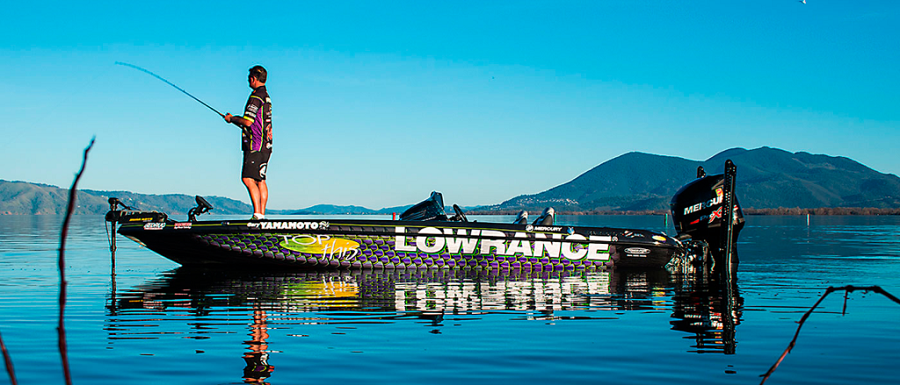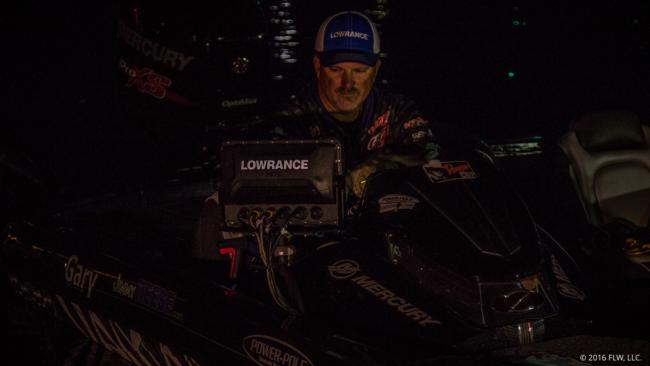
Your electronics are your eyes underneath the surface and one of the most critical times to use them is in the fall. FLW Tour pro Jimmy Reese relies on all of the Lowrance technologies to locate bass, structure, and baitfish. He shares some tips on what he looks for when autumn hits.
Mapping for Bass
The quality of today’s mapping makes it much easier for an angler to locate fishing areas. Reese says one of the keys this time of year is finding flats.
“Flat areas are a big advantage for bass pushing baitfish from deep water. It is really easy to find flats with the C-Map mapping,” he says.
Once he locates a potentially good location on the map, he then idles and utilizes StructureScan to get a better look at the structure in the area. What he is looking for is baitfish, bass and any type of structure that is different along the flats.
 2D Sonar for Vegetation
2D Sonar for Vegetation
Reese says 2D sonar is one of the best ways to locate vegetation and is also a great tool for locating baitfish.
“It is easy to see the grass and then you can go back and use StructureScan to find those key spots within the grass,” he says and adds that he often runs at a slow speed while looking for grass and vegetation. This helps him cover more water than idling.
“If you are running slowly you will see your graph light up with baitfish and then you can slow down and idle to get a better look. It is critical to find some baitfish because if you find the bait you will find the bass in the fall," he says.
READ RELATED: Lowrance Screenshot Interpretation | White Bass | Rock Shoal Transition | Deep Flat with Jordan Lee
StructureScan to Find Structure
There are many reasons to using StructureScan in the fall and Reese says it helps to find structure in vast expanses of grass and also helps him find the best docks to fish.
“You may find a grass line and then you can idle and watch your graph to find the boulders, laydowns, or even a depth change of two-feet in the vegetation. Those little differences are what will hold fish when there is a lot of grass,” he says.
Once he sees the object on the screen, it is as simple as touching the screen and saving a waypoint to return to.
“I mark that waypoint and then can come back through when I am fishing and cast right to it,” he says.
When faced with dock after dock on a lake, Reese will rely on StructureScan to get a look under the docks. “Understanding what is under the docks is a big help. You can see manmade rock piles, brush piles and anything else that makes one dock different than the others,” he says.
DownScan for Video Gaming Bass
DownScan and 2D sonar are both excellent tools for viewing what is directly under the boat, but Reese has preferences for each of them. “I like using DownScan more when I am 'video gaming' deep spotted bass. Typically I use it more when I am fishing and not searching for fish," he says.
DownScan also helps Reese get a better picture of what the fish are doing.
“It is easier for me to look at DownScan and understand the position that fish are in relation to the bottom. It shows whether they are suspended or tight to the bottom," he says.
 Finding Rockpiles and Creek Channels for Fall Holding Spots
Finding Rockpiles and Creek Channels for Fall Holding Spots
Rocks are a key area for bass in the fall and Reese will use every Lowrance technology to help him to find rockpiles.
“I like to look for rock piles or creek channels, or better yet rock piles in the creeks because that is where you will find baitfish,” he says.
The first step for him is to locate areas on his C-MAP mapping.
“I find the areas and then spend the time idling looking for baitfish and those rockpiles. Generally, I have my StructureScan set to 25- to 30-feet to both sides of the boat when I am scanning," he adds.
READ RELATED: Lowrance Screenshot Interpretation | Schooling | Lasagna | Diagonals
Use Your Trails to Capitalize on Fall Bass
Locating vegetation is simple in the summer and early fall, just look for the matted grass and start fishing. As the water cools down and the grass line recedes, it can be more difficult. Reese shared a tip he uses to stay on grass lines well into the fall.
“If you idle along the edge of the grass, you can save that trail for future reference. I like to save it as a different color so I can come back to that later in the fall when the grass dies and still be fishing what is left of the weed line,” he says.
The fall of the year is a time when the bass are feeding heavily on baitfish. Finding the baitfish can be the biggest key to success and pro anglers like Jimmy Reese use their Lowrance units to speed up the search. Once baitfish are found, fall bass fishing can be some of the best of the year.


 Advertising
Advertising